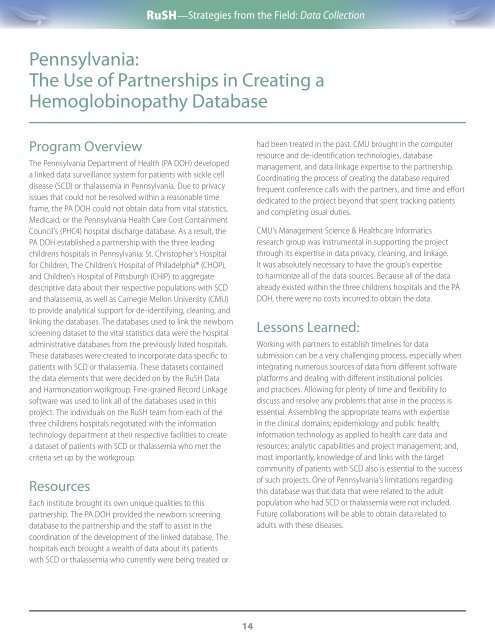RuSH: Strategies from the Field - Centers for Disease Control and ...
RuSH: Strategies from the Field - Centers for Disease Control and ...
RuSH: Strategies from the Field - Centers for Disease Control and ...
You also want an ePaper? Increase the reach of your titles
YUMPU automatically turns print PDFs into web optimized ePapers that Google loves.
<strong>RuSH</strong>—<strong>Strategies</strong> <strong>from</strong> <strong>the</strong> <strong>Field</strong>: Data Collection<br />
Pennsylvania:<br />
The Use of Partnerships in Creating a<br />
Hemoglobinopathy Database<br />
Program Overview<br />
The Pennsylvania Department of Health (PA DOH) developed<br />
a linked data surveillance system <strong>for</strong> patients with sickle cell<br />
disease (SCD) or thalassemia in Pennsylvania. Due to privacy<br />
issues that could not be resolved within a reasonable time<br />
frame, <strong>the</strong> PA DOH could not obtain data <strong>from</strong> vital statistics,<br />
Medicaid, or <strong>the</strong> Pennsylvania Health Care Cost Containment<br />
Council’s (PHC4) hospital discharge database. As a result, <strong>the</strong><br />
PA DOH established a partnership with <strong>the</strong> three leading<br />
childrens hospitals in Pennsylvania: St. Christopher’s Hospital<br />
<strong>for</strong> Children, The Children’s Hospital of Philadelphia® (CHOP),<br />
<strong>and</strong> Children’s Hospital of Pittsburgh (CHIP) to aggregate<br />
descriptive data about <strong>the</strong>ir respective populations with SCD<br />
<strong>and</strong> thalassemia, as well as Carnegie Mellon University (CMU)<br />
to provide analytical support <strong>for</strong> de-identifying, cleaning, <strong>and</strong><br />
linking <strong>the</strong> databases. The databases used to link <strong>the</strong> newborn<br />
screening dataset to <strong>the</strong> vital statistics data were <strong>the</strong> hospital<br />
administrative databases <strong>from</strong> <strong>the</strong> previously listed hospitals.<br />
These databases were created to incorporate data specific to<br />
patients with SCD or thalassemia. These datasets contained<br />
<strong>the</strong> data elements that were decided on by <strong>the</strong> <strong>RuSH</strong> Data<br />
<strong>and</strong> Harmonization workgroup. Fine-grained Record Linkage<br />
software was used to link all of <strong>the</strong> databases used in this<br />
project. The individuals on <strong>the</strong> <strong>RuSH</strong> team <strong>from</strong> each of <strong>the</strong><br />
three childrens hospitals negotiated with <strong>the</strong> in<strong>for</strong>mation<br />
technology department at <strong>the</strong>ir respective facilities to create<br />
a dataset of patients with SCD or thalassemia who met <strong>the</strong><br />
criteria set up by <strong>the</strong> workgroup.<br />
Resources<br />
Each institute brought its own unique qualities to this<br />
partnership. The PA DOH provided <strong>the</strong> newborn screening<br />
database to <strong>the</strong> partnership <strong>and</strong> <strong>the</strong> staff to assist in <strong>the</strong><br />
coordination of <strong>the</strong> development of <strong>the</strong> linked database. The<br />
hospitals each brought a wealth of data about its patients<br />
with SCD or thalassemia who currently were being treated or<br />
14<br />
had been treated in <strong>the</strong> past. CMU brought in <strong>the</strong> computer<br />
resource <strong>and</strong> de-identification technologies, database<br />
management, <strong>and</strong> data linkage expertise to <strong>the</strong> partnership.<br />
Coordinating <strong>the</strong> process of creating <strong>the</strong> database required<br />
frequent conference calls with <strong>the</strong> partners, <strong>and</strong> time <strong>and</strong> ef<strong>for</strong>t<br />
dedicated to <strong>the</strong> project beyond that spent tracking patients<br />
<strong>and</strong> completing usual duties.<br />
CMU’s Management Science & Healthcare In<strong>for</strong>matics<br />
research group was instrumental in supporting <strong>the</strong> project<br />
through its expertise in data privacy, cleaning, <strong>and</strong> linkage.<br />
It was absolutely necessary to have <strong>the</strong> group’s expertise<br />
to harmonize all of <strong>the</strong> data sources. Because all of <strong>the</strong> data<br />
already existed within <strong>the</strong> three childrens hospitals <strong>and</strong> <strong>the</strong> PA<br />
DOH, <strong>the</strong>re were no costs incurred to obtain <strong>the</strong> data.<br />
Lessons Learned:<br />
Working with partners to establish timelines <strong>for</strong> data<br />
submission can be a very challenging process, especially when<br />
integrating numerous sources of data <strong>from</strong> different software<br />
plat<strong>for</strong>ms <strong>and</strong> dealing with different institutional policies<br />
<strong>and</strong> practices. Allowing <strong>for</strong> plenty of time <strong>and</strong> flexibility to<br />
discuss <strong>and</strong> resolve any problems that arise in <strong>the</strong> process is<br />
essential. Assembling <strong>the</strong> appropriate teams with expertise<br />
in <strong>the</strong> clinical domains; epidemiology <strong>and</strong> public health;<br />
in<strong>for</strong>mation technology as applied to health care data <strong>and</strong><br />
resources; analytic capabilities <strong>and</strong> project management; <strong>and</strong>,<br />
most importantly, knowledge of <strong>and</strong> links with <strong>the</strong> target<br />
community of patients with SCD also is essential to <strong>the</strong> success<br />
of such projects. One of Pennsylvania’s limitations regarding<br />
this database was that data that were related to <strong>the</strong> adult<br />
population who had SCD or thalassemia were not included.<br />
Future collaborations will be able to obtain data related to<br />
adults with <strong>the</strong>se diseases.

















